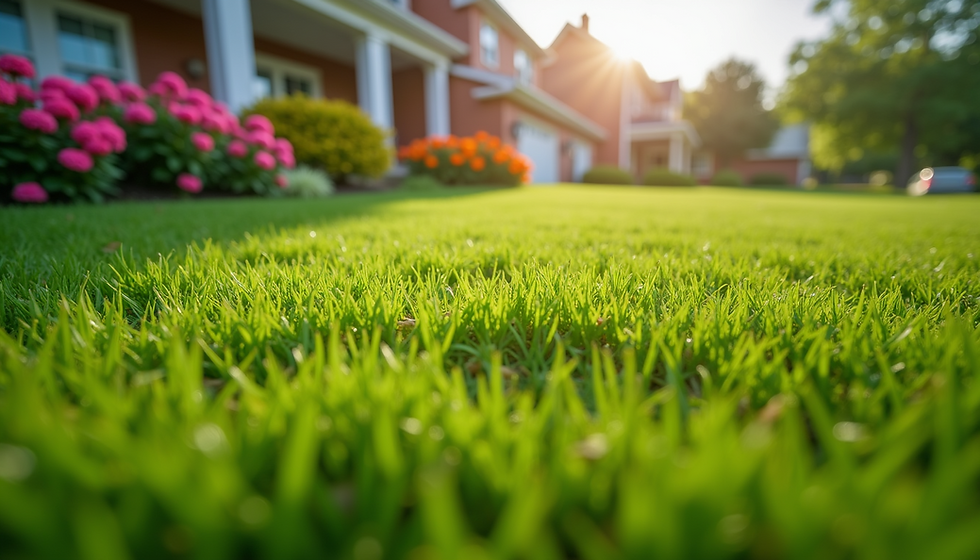Essential Fall Treatments for Your Yard to Prepare for Winter and Boost Spring Growth
- Timothy Jacobs
- Sep 24
- 3 min read
As fall rolls in and nature showcases its stunning colors, it’s time to focus on essential treatments for your yard. These treatments not only protect your plants from winter's chill but also lay the groundwork for a vibrant spring. Let’s dive into these critical steps, their benefits, and the optimal timing to implement them.

Lawn Aeration
One of the best fall treatments for your yard is lawn aeration. This process involves creating holes in the soil, allowing air, water, and nutrients to reach the roots. Aeration is particularly helpful because it combats soil compaction, which can limit root growth and water absorption.
Best Time to Apply: Aim for late summer to early fall for aeration. During this time, grass is actively growing, leading to quicker recovery.
Overseeding
After aeration, overseeding is a perfect follow-up to revitalize your lawn. This process involves spreading grass seed across your existing lawn to fill in bare spots and enhance density. Overseeding is an excellent way to introduce grass varieties that thrive better in your climate. For example, mixing in drought-resistant varieties can drastically improve your lawn's resilience.
Best Time to Apply: Early to mid-fall is ideal due to cooler temperatures and sufficient moisture.
Fertilization
Applying a fall fertilizer is crucial for preparing your lawn for winter. A quality fertilizer can provide key nutrients that support root growth and help your grass endure harsh conditions. Look for a fertilizer with a higher potassium content, which improves drought resistance and boosts overall plant health. For instance, a balanced fertilizer ratio of 5-10-30 (N-P-K) can be especially effective in strengthening roots before winter.
Best Time to Apply: Fertilization should be conducted in late fall, preferably about 4-6 weeks before the ground freezes.
Leaf Cleanup
Cleaning up fallen leaves might seem tedious, but it's vital for your lawn's health. Accumulated leaves can suffocate grass and create breeding grounds for pests and diseases. Regularly raking or using a leaf blower can keep your lawn healthy and thriving.
Best Time to Apply: Start cleaning as soon as leaves begin to fall and continue to do so throughout the fall season.
Mulching
Mulching is another effective fall treatment. Applying a layer of mulch around trees and flower beds can help retain moisture, suppress weeds, and regulate soil temperature. Organic mulches, such as shredded leaves or wood chips, also improve soil health as they decay. Studies show that properly mulched plants can retain 30% more moisture than those without it.
Best Time to Apply: Late fall is the best time for mulching, especially before the first snowfall.
Winterizing Your Irrigation System
If you have an irrigation system, taking steps to winterize it is crucial. This process involves draining the system and blowing out the lines to prevent water from freezing inside and causing pipe bursts.
Best Time to Apply: Winterization should be completed in late fall, prior to the first hard freeze.
Planting Bulbs
Fall is the perfect time to plant spring-flowering bulbs, like tulips and daffodils. By planting in the fall, these bulbs can establish their roots before the winter freeze, leading to a spectacular display when spring arrives. For example, planting 50 bulbs in your garden can result in thousands of blooms, making your outdoor space come alive.
Best Time to Apply: Plant bulbs in early to mid-fall, about 6-8 weeks before the ground freezes.
Pruning
Pruning is an essential treatment for many trees and shrubs. Removing dead or diseased branches helps improve air circulation and minimizes the risk of pests and diseases. For instance, cutting back a notable percentage of overcrowded branches can allow more light to reach the remaining leaves, benefiting the overall plant health.
Best Time to Apply: Late fall is generally the best time for pruning, after the leaves have fallen but before the first frost.
Soil Testing
Taking the time to conduct a soil test in the fall can provide critical insights into nutrient levels and pH in your soil. This information helps you determine the right fertilizers and amendments needed for optimal plant health. A soil test can reveal if your soil is deficient in key nutrients, empowering you to make informed decisions for healthier plants come spring.
Best Time to Apply: Soil testing can be performed anytime in the fall, allowing you to prepare ahead for spring planting.
Final Thoughts
As the fall season unfolds, implementing these essential treatments can dramatically improve your yard's resilience against winter. From aeration and overseeding to effective fertilization and leaf cleanup, each step contributes to your landscape's health. By following these insightful guidelines and applying treatments at the right times, you can ensure that your yard flourishes through the seasons. Embrace the beauty of fall while preparing your yard for winter and the promising growth of spring!










Comments